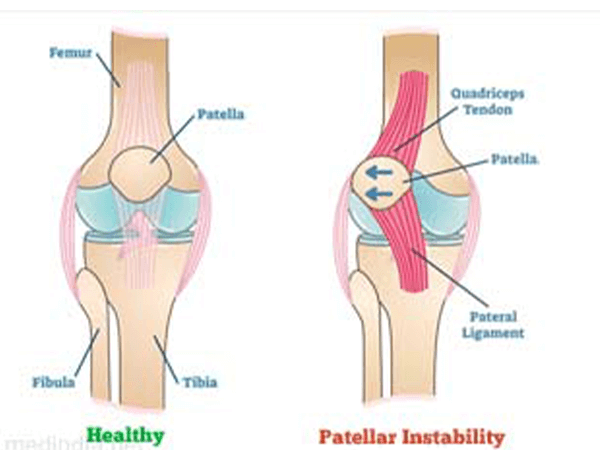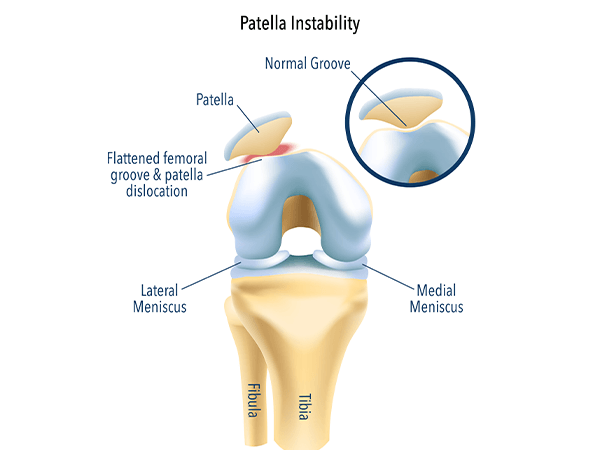Patellar instability is a condition in which the kneecap (patella) slips out of its normal position in the groove of the thighbone (femur). This can cause pain, swelling, and a clicking or popping sensation in the knee.
There are two types of patellar instability:
Traumatic patellar instability: This type of instability is caused by a sudden injury to the knee, such as a fall or a sports injury.
Chronic patellar instability: This type of instability is caused by a gradual weakening of the muscles and ligaments around the knee. This can be due to several factors, including:
Female gender
A family history of patellar instability
A high-arched foot
Weak quadriceps muscles
Tight hamstrings
Genu valgus (knock knees)
The symptoms of patellar instability can vary depending on the severity of the condition. Some people may only experience occasional pain and popping, while others may have recurrent dislocations of the kneecap.
Rest: This may involve using crutches or a knee brace to avoid putting weight on the affected knee.
Ice: This can help to reduce pain and swelling.
Compression: This can help to reduce swelling.
Elevation: This can help to reduce swelling.
Physical therapy: This can help to strengthen the muscles and ligaments around the knee.
Surgery: In some cases, surgery may be necessary to correct the alignment of the kneecap or to tighten the ligaments around the knee.
The goal of treatment for patellar instability is to reduce pain and improve function. With proper treatment, most people with patellar instability can return to their normal activities.

Here are some tips to help prevent patellar instability:
Warm up before exercising: This will help to loosen the muscles and ligaments around the knee.
Strengthen the muscles around the knee: This will help to stabilize the knee joint.
Stretch the muscles around the knee: This will help to improve flexibility and range of motion.
Wear proper footwear: This will help to support the arch of the foot and reduce stress on the knee.
Avoid activities that put stress on the knee: If you have a history of patellar instability, it is important to avoid activities that put stress on the knee, such as jumping, running, and downhill skiing.
Acute Kneecap Instability
Acute kneecap instability is a condition in which the kneecap (patella) slips out of place. This can happen suddenly, usually because of a traumatic injury, or it can develop gradually over time.
Treatment for acute kneecap instability will vary depending on the severity of the injury. In some cases, conservative treatment, such as rest, ice, compression, and elevation (RICE), may be all that is needed. In other cases, surgery may be necessary to repair any damage to the ligaments or muscles around the knee.
The goal of treatment is to reduce pain and inflammation, restore stability to the knee, and prevent further injuries.
With proper treatment, most people with acute kneecap instability make a full recovery. However, there is a risk of recurrence, especially in people who have had previous knee injuries or other risk factors.
Here are some tips to help prevent acute kneecap instability:
- Strengthen your quadriceps muscles.
- Wear shoes with good arch support.
- Avoid activities that put stress on your knees.
- Lose weight if you are overweight or obese.
- Stretch your hamstrings and quadriceps muscles regularly.
- If you have a history of knee injuries, talk to your doctor about ways to reduce your risk of further injuries.
What are the Symptoms of Chronic Kneecap Instability?
Chronic kneecap instability is a condition in which the kneecap (patella) repeatedly slips out of place. This can cause pain, swelling, and difficulty walking.
The symptoms of chronic kneecap instability can vary from person to person, but they may include:
- Pain in the front of the knee
- Swelling in the knee
- A feeling of instability or weakness in the knee
- The kneecap may pop out of place or feel like it is about to pop out of place.
- Difficulty walking or running.
If you experience any of these symptoms, it is important to see a doctor to get a diagnosis and treatment.

There are several things that can cause chronic kneecap instability, including:
- A history of knee injuries
- Weak or tight muscles around the knee
- An abnormal alignment of the kneecap
- A high Q-angle, which is the angle between the thighbone (femur) and the shinbone (tibia)
Treatment for chronic kneecap instability will vary depending on the severity of the condition. In some cases, treatment may involve physical therapy, strengthening exercises, and wearing a brace. In more severe cases, surgery may be necessary to realign the kneecap or correct any underlying muscle or ligament problems.
With proper treatment, most people with chronic kneecap instability can return to normal activities. However, it is important to continue with physical therapy and strengthening exercises to prevent the condition from recurring.
